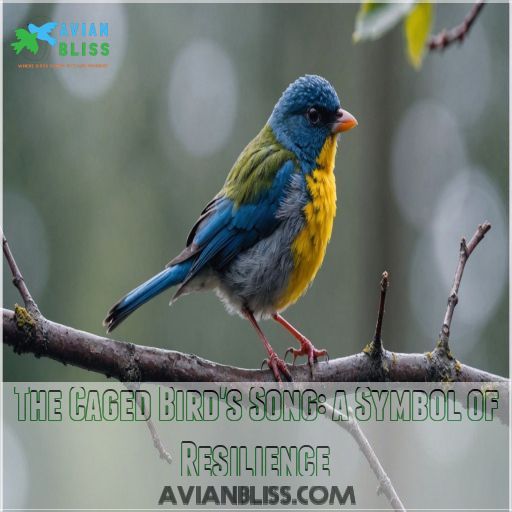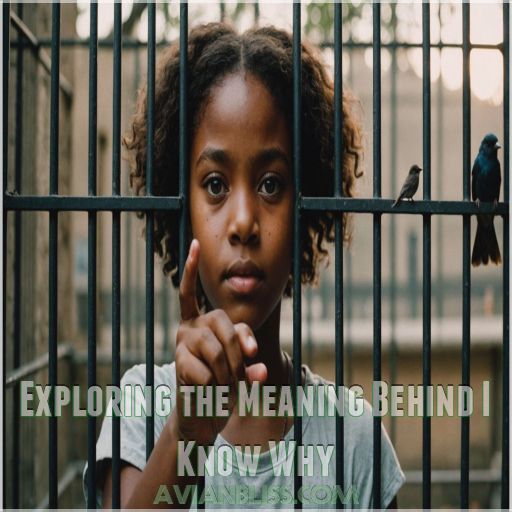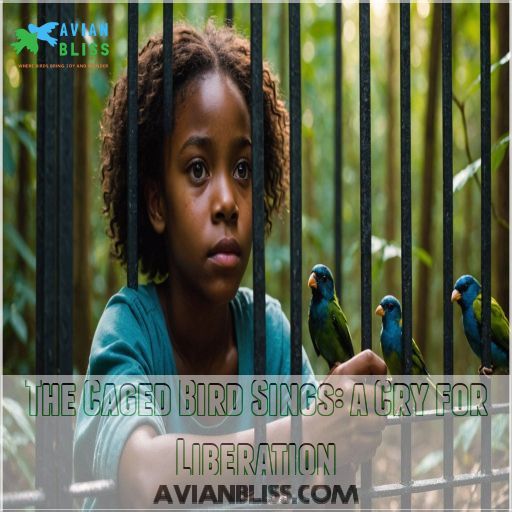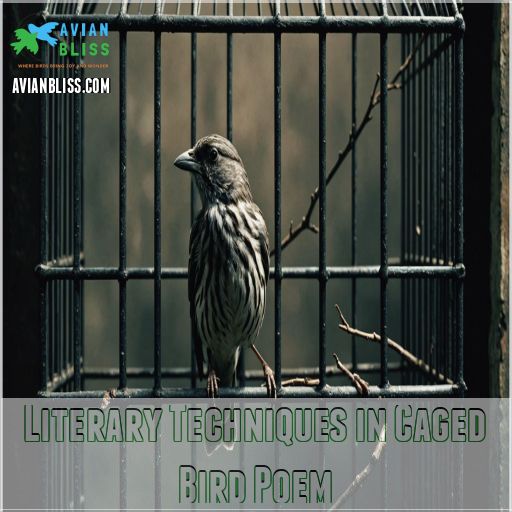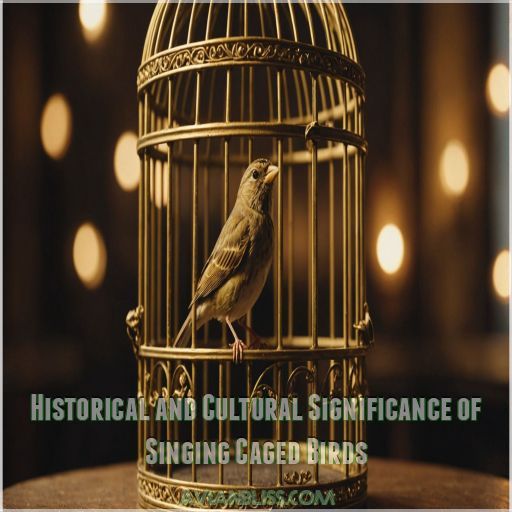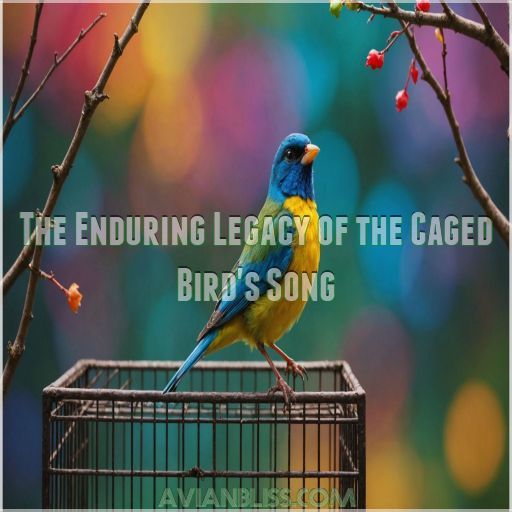This site is supported by our readers. We may earn a commission, at no cost to you, if you purchase through links.

Despite its clipped wings and narrow bars, the bird sings to express its longing for freedom. This isn’t just about birds, though. Maya Angelou’s metaphor reveals the spirit’s endurance amid oppression and injustice.
The song symbolizes a powerful protest and a plea for liberation. It’s a bit like when you’re stuck in a meeting, and your mind wanders yearning for the weekend.
Just as the bird’s song echoes resilience, there’s more to explore here! The concept also represents a powerful form of protest.
Table Of Contents
- Key Takeaways
- The Caged Bird’s Song: a Symbol of Resilience
- Exploring the Meaning Behind I Know Why
- The Psychology of Singing Despite Captivity
- Freedom Vs. Captivity: Contrasting Bird Imagery
- The Caged Bird Sings: a Cry for Liberation
- Literary Techniques in Caged Bird Poem
- Historical and Cultural Significance of Singing Caged Birds
- The Enduring Legacy of the Caged Bird’s Song
- Frequently Asked Questions (FAQs)
- What does I know why the caged bird sings mean?
- Does Maya Angelou know why the caged bird sings?
- Is I know why the caged bird sings a good book?
- Why does a caged bird open his throat to sing?
- What is the main message of "I know why the caged bird sings"?
- What purpose does the caged bird sings?
- What song is the caged bird singing and why?
- Why is why the caged bird sings banned?
- How does Angelous personal life influence her work?
- What impact did the memoir have on readers?
- What challenges does the book face in education?
- How is trauma depicted in the narrative?
- Why is the caged bird a powerful symbol?
- Conclusion
Key Takeaways
- The caged bird’s song symbolizes resilience and hope in the face of oppression, inspiring us to find strength and express ourselves even when facing life’s toughest challenges.
- Maya Angelou’s powerful metaphor of the caged bird connects to broader themes of identity, empathy, and the universal human struggle for freedom and dignity, transcending cultural boundaries.
- Creativity and self-expression, like the caged bird’s song, can serve as powerful coping mechanisms and therapeutic outlets, helping us navigate difficult circumstances and maintain our mental well-being.
- The contrasting imagery of the free bird and the caged bird highlights the disparities between freedom and captivity, reminding us to appreciate the liberties we have while also standing in solidarity with those who are still seeking to break free.
The Caged Bird’s Song: a Symbol of Resilience
In Maya Angelou’s "Caged Bird," you’ll find a song birthed from struggle, as even a bird in captivity can show resilience and hope.
Imagine facing life’s challenges with a karaoke mic in hand—Angelou’s metaphor reminds us that the voice can rise despite bars.
Maya Angelou’s Powerful Metaphor
In Maya Angelou’s poem, the caged bird symbolizes resilience amid racial oppression. The metaphor of the caged bird’s song is a powerful symbol of the spirit’s endurance, echoing the wisdom of brown birds and their symbolism of spiritual protection
.
Consider this: The caged bird sings despite captivity, Its song echoes hope, and The free bird represents unbridled freedom.
The caged bird’s melody embodies the spirit’s endurance, as Remember, the caged bird’s melody embodies resilience.
Historical Context of Oppression and Resistance
Imagine enduring the suffocating confines of Jim Crow laws and segregation.
African Americans faced racial inequality head-on, often summoning resilience from the depths of their souls.
During the Civil Rights era, fueled by the Black Power movement, communities resisted oppression reminiscent of Angelou’s caged bird. This metaphorically captures struggles from the Great Depression to childhood trauma.
The Bird’s Song as a Form of Protest
Though physically confined, the caged bird’s song becomes a powerful form of protest, a defiant cry for freedom that resonates across the distant hills.
Angelou’s metaphor captures the resilience of the oppressed, who find creative expression to voice their longing for liberation, inspiring solidarity and change within their community. (Source)
Resilience in the Face of Adversity
While protest forms the backbone of the caged bird’s song, your spirit of resilience truly shines through adversity.
Like Angelou defied life’s cruelties, you find strength and healing from childhood trauma and sexual abuse, embracing hope and empowerment.
With each struggle, resilience isn’t just survival—it’s a civil rights anthem, fostering unwavering strength and coming of age.
The Universal Appeal of the Caged Bird’s Song
Hope and resilience echo through Maya Angelou’s words as the caged bird sings, a universal appeal that transcends cultural boundaries.
It’s about identity and empathy, connecting us all in a shared struggle for freedom and dignity.
Through African American free verse, Angelou highlights family relationships and common dreams, reminding you of the unbreakable spirit we all share.
Exploring the Meaning Behind I Know Why
You might wonder why a caged bird would sing, and Maya Angelou offers profound insights into this mystery.
Her personal experiences, along with the collective wisdom of oppressed communities, reveal that even in confinement, the human spirit seeks expression through shared stories and cultural memories.
This quest for expression is a fundamental aspect of the human experience, and it is beautifully captured in the human spirit‘s ability to find ways to express itself, even in the most challenging circumstances.
Maya Angelou’s Personal Experiences and Insights
Maya Angelou’s personal experiences in "I Know Why the Caged Bird Sings" highlight her journey of self-discovery amid childhood trauma and racism’s impact.
Discovering her voice, despite feeling caged by societal constraints, she mothers resilience and literary influence.
Angelou’s insights remind you that, like the caged bird, your song can soar beyond limitations, offering hope and freedom .
The Collective Knowledge of Oppressed Communities
Imagine the strength of a community’s shared narratives intertwined with historical trauma.
This collective knowledge fosters cultural resilience, allowing voices like Maya Angelou’s to echo ‘Still I rise’ and ‘Phenomenal Woman.’
Through these stories, oppressed communities nurture intergenerational impact and collective healing, weaving a tapestry of resilience that’s as essential as air for the caged bird.
Empathy and Understanding for the Caged Bird’s Plight
Think of the caged bird as a symbol of empathy. When we really understand its song, we see glimpses of shared struggles and resilience. Human resilience shines most brightly in adversity, where the call for understanding echoes.
- Relate to symbolic imagery: Birds’ songs echo cultural context.
- Explore empathy’s depth: Unearth personal growth.
- Social justice insights: Stand with still rising voices.
Knowing this bird’s plight, you stand shoulder to shoulder with those who dare to sing.
The Power of Shared Experiences and Cultural Memory
As you read Angelou’s words, you may feel a deep kinship with her experiences, even if your own upbringing differed.
This shared cultural memory, passed down through generations, allows us to empathize with the caged bird’s plight and find solace in its resilient song (Source).
Our collective traumas bind us together, inspiring hope for liberation.
Uncovering Hidden Truths Through Literature and Art
Discovering the truths in Angelou’s work, art becomes a beacon for social justice, revealing hidden meanings within its stanzas.
The caged bird’s song echoes against sighing trees and onto a bright lawn—a plea amid captivity’s shadows.
Through vivid imagery, like fat worms, Angelou bridges cultural impacts and literary devices, encouraging readers to seek liberation .
The Psychology of Singing Despite Captivity
Ever wonder why even in captivity, a bird still sings its heart out?
This resilience reflects the power of expressing emotions and finding purpose amid life’s toughest challenges.
Perhaps a lesson for us all when facing a bad hair day or an endless to-do list, illustrating how to find strength in expressing emotions.
Coping Mechanisms in Challenging Circumstances
You might wonder why the caged bird sings despite its constraints.
It’s not just for a catchy tune or to please listeners on "distant hills" .
It’s a deep act of resilience, a shout against captivity.
In tough times, self-expression becomes the bird’s art therapy, a healing song of hope, whispered in "iambic meter.
The Role of Creativity in Maintaining Mental Health
Creativity acts like a trusty umbrella on a rainy day; it shields your mental well-being by brightening even the grayest skies.
When life’s challenges threaten your peace, creativity’s benefits shine through, offering art therapy and finding purpose.
It’s a lifeline, bringing emotional expression and a bit of humor to help weather the storm.
Expressing Emotions Through Song and Art
Though the bird’s cage limits its wings, it still finds a voice to sing, providing a powerful metaphor for emotional expression through art and music.
Consider these ways it heals:
- Therapy: Channels raw emotions into melody
- Art: Transforms pain into beauty
- Healing: Offers relief from captivity
- Expression: Voices longing for liberty
This metaphor resonates globally, inspiring resilience.
Finding Purpose and Meaning in Difficult Situations
When life’s challenges feel like towering mountains, finding purpose and meaning becomes your guiding star. Just like Maya Angelou’s caged bird, you sing even when stifled.
This act of self-discovery can bring hope and resilience. Remember, each note you sing writes your story, uncovering strength within.
| Aspect | Feeling | Outcome |
|---|---|---|
| Hope | Joyful | Liberation |
| Resilience | Empowered | Perseverance |
| Self-Discovery | Enlightened | Clarity |
| Healing | Relieved | Peace |
The Healing Power of Self-expression
In tough times, finding purpose becomes a guiding star.
You might’ve felt trapped, like a caged bird, but self-expression through art, music, or writing offers a lifeline.
It’s therapy in disguise—music heals, writing releases, and poetry transforms trauma into resilience.
Embrace creativity; it’s your secret weapon against life’s cages, your own liberating melody.
Freedom Vs. Captivity: Contrasting Bird Imagery
In Maya Angelou’s work, you’ll discover how contrasting bird imagery paints a vivid picture of freedom and captivity.
While the free bird’s limitless sky symbolizes endless possibilities, the caged bird’s bars illustrate real-life struggles many face.
With a sprinkle of irony that even the free bird seems to hush the power of imagination.
The Free Bird’s Effortless Flight and Limitless Possibilities
Imagine a bird soaring freely, its wings slicing through the sky like a hot knife through butter.
This free bird symbolizes unbounded potential and dreams, where hope is limitless.
It claims the sky, reveling in its liberation, embodying the idea that with freedom, anything is possible.
Like you pursuing your dreams, this idea represents the concept that with freedom, anything is possible.
The Caged Bird’s Physical and Emotional Constraints
You’ve soared with the free bird.
Now, taste the bittersweet tale of the caged bird—trapped, yet dreaming.
Its limited movement echoes life’s confines, while internalized oppression clips its wings, sparking a fear of freedom.
This longing soul sings of a hope for escape, clinging to its fading identity amidst the bars of constraint .
Symbolism of Wings, Bars, and Narrow Cages
As you consider the caged bird’s plight, its clipped wings and narrow cage bars embody confinement, limiting hope.
But look beyond the bars to find resilience: Wings clipped, dreams grounded. Bars of rage, anger mounting. Narrow cages, opportunity restricted.
Yet, a song arises—symbolizing enduring hope and longing for freedom.
The Irony of the Free Bird’s Silence
It’s ironic how the free bird’s silence can weigh as heavily as the caged bird’s song. This burden of freedom contrasts the power found in confined voices searching for liberation. While the free bird soars, free from bars, it misses the caged bird’s hopeful cries, reminding us that freedom’s cost includes understanding the absence of hope.
| Free Bird’s Silence | Caged Bird’s Power | Meaning of Silences |
|---|---|---|
| No constraints | Vocal protest | Freedom’s cost |
| Missed voices | Hopeful cries | Hopes absence |
| Heavy silence | Resilient song | Words unspoken |
The Power of Imagination in Overcoming Limitations
Though the caged bird’s physical freedom may be limited, its imagination soars, opening up inner spaces of hope and resilience.
By channeling creativity, the captive bird transcends its constraints, finding solace in the power of self-expression.
This metaphor reminds us that even in the darkest times, the human spirit can triumph through the transformative force of the mind .
The Caged Bird Sings: a Cry for Liberation
Have you ever wondered why some voices seem to rise above their circumstances with a strength that can’t be caged?
In Maya Angelou’s powerful poem, the caged bird sings as a cry for liberation, shedding light on the struggles for freedom and justice while inspiring hope and solidarity among the oppressed.
The Song as a Plea for Freedom and Equality
Picture the caged bird’s song as a powerful plea for freedom and equality, resonating with anyone who feels trapped. While its wings are clipped, its hope and resilience soar.
You might think it’s just a bird, but:
- The song symbolizes unyielding spirit.
- It illustrates the universal longing for liberation.
- Its melody inspires change and understanding.
Raising Awareness of Social Injustices
As the caged bird sings, it opens eyes to the world’s injustices, much like a wake-up call that can’t be ignored.
By highlighting social justice movements and exposing systemic oppression, Angelou’s work underscores racial inequality and cultural bias, sparking a fight for equality.
It’s more than a song; it’s a persistent reminder not to overlook these struggles , a persistent reminder that serves as a call to action.
Inspiring Hope and Solidarity Among the Oppressed
Imagine the caged bird’s song as a rallying cry, lifting spirits and forging connections among the oppressed.
Through shared struggles and a collective voice, Maya Angelou highlights the power of finding strength and hope for change.
Her work inspires unity and determination, helping individuals overcome adversity by drawing on a wellspring of courage and resilience.
Challenging the Status Quo Through Art
When you explore Maya Angelou’s art, you uncover a cultural critique challenging the status quo.
Her caged bird sings not just for hope but loudly demands social change.
This artistic activism, wrapped in powerful metaphors, nudges us to question life’s unfair confines.
Revolutionary art like Angelou’s sparks conversation and inspires action.
The Transformative Power of the Bird’s Song
The caged bird’s song holds transformative power.
See how it brings hope, a cry for liberation and resilience:
- Find liberation in the bird’s hopeful tune, echoing across hills.
- Embrace resistance through song, fueling courage against oppression.
- Feel hope ignite, as each note defies captivity’s chains.
- Inspire resilience, turning heartache into a symphony of freedom.
Literary Techniques in Caged Bird Poem
Maya Angelou’s iconic poem "Caged Bird" utilizes a range of literary techniques to convey its powerful message.
From the rhythmic repetition of key phrases to the vivid imagery that transports readers, the poem’s artistry amplifies its timeless themes of oppression and resilience.
Repetition and Refrain for Emotional Impact
Repetition and refrain in "Caged Bird" create emotional impact, akin to an echoing heart. They emphasize the bird’s persistent cry for freedom, making you feel its plight deeply.
This technique turns poetry into a powerful song, resonating in your mind.
| Technique | Purpose |
|---|---|
| Repetition | Emotional impact |
| Refrain | Emphasize longing |
| Lyrical tone | Create resonance |
| Rhythm | Emotional flow |
| Poetic cry | Amplify emotion |
Angelou uses these devices brilliantly.
Vivid Imagery and Sensory Details
Reading Maya Angelou’s "Caged Bird," you’re immersed in vivid imagery and sensory details that bring the birds to life.
Feel the:
- Free bird’s wings brush the vibrant orange sun rays.
- Caged bird’s cries echo in the eerie quiet.
The atmosphere is further enhanced by:
- Tender whispers from the trade winds through sighing trees.
Ultimately, the poem evokes a sense of longing and loss, particularly:
- Heartbreak of dreams buried beneath clipped wings.
Metaphors and Symbolism Throughout the Poem
You can’t miss Maya Angelou’s metaphors and symbolism in "Caged Bird." The free bird’s flight embodies freedom’s song, contrasting with the caged bird trapped by oppression’s bars.
It’s a universal struggle, highlighting hope’s resonance despite captivity.
Angelou’s imagery invites you to empathize with the bird’s longing, connecting deeply with your innate desire for liberation and understanding.
Structure and Rhythm Enhancing the Message
Maya Angelou’s poem dances with rhythm and flow.
The free verse structure breathes life into the contrasting bird imagery, while iambic meter subtly builds tension. Alliteration adds a musical quality, making the message resonate deeply.
With skillful enjambment, Angelou captures freedom’s elusive nature and the caged bird’s yearning—a mesmerizing blend of form and feeling that hits home.
Contrasting Language to Highlight Disparities
Highlighting disparities through contrasting language, Angelou crafts vivid images of both power and oppression.
The free bird enjoys autonomy, while the caged bird embodies restricted identity and yearning for freedom. This contrast emphasizes the emotional impact of confinement versus liberation.
This inequality serves as a reminder of the resilience in adversity and the unwavering desire for autonomy.
Historical and Cultural Significance of Singing Caged Birds
In exploring the historical and cultural significance of singing caged birds, you’ll find insights that span ancient traditions of keeping songbirds to powerful symbols across cultures.
It’s like discovering an unexpected connection between a tiny bird’s melody and the vast tapestry of African American literature, all while enjoying the musical influences that shaped Maya Angelou’s work.
Ancient Traditions of Keeping Songbirds
Tracing the ancient roots of songbird captivity, we uncover a rich tapestry of cultural symbolism and domestic ideals.
From colonial America to the Romantic era, these winged marvels embodied ideals of femininity, piety, and familial harmony.
Their melodies echoed the longing for home, comfort, and control over the natural world.
Symbolism in Various Cultures and Religions
You might think symbol-filled cages are a bit on the nose, but who doesn’t love a good metaphor? Around the world, caged birds reflect confinement and yearning for freedom, seen in art, literature, and religion.
Consider:
- They symbolize oppression, especially in feminist themes.
- They’re tied to spiritual longing and liberation.
- They embody resilience and hope through song.
The Caged Bird in African American Literature
Just like ancient songbirds conveyed messages across cultures, the caged bird in African American literature symbolizes the Black art of expressing freedom struggles and racial injustice.
Maya Angelou taps into this literary legacy, weaving cultural identity and resilience into narratives.
The caged bird’s song has become synonymous with the struggle for freedom and equality, often serving as a powerful form of protest that resonates deeply with those yearning for freedom.
Through this powerful metaphor, Angelou also invites readers to feel the stark contrast between freedom and captivity.
Let’s explore how the caged bird’s resilient song challenges oppression with grace and strength.
Musical Influences on Maya Angelou’s Work
Imagine diving into a jazz riff, where rhythms bounce and melodies soar.
Maya Angelou infused her writing with the soul of blues, gospel, and rhythm & blues.
This blend of musical influences mirrors themes in African American literature by:
- Celebrating resilience and spirit.
- Emphasizing community strength.
- Voicing struggles and triumphs with soulful depth.
Contemporary Interpretations and Adaptations
In today’s world, the caged bird’s song finds resonance in films and modern music adaptations, drawing from Angelou’s profound metaphor.
Contemporary poetry continues this legacy, sparking social justice movements that echo the call for freedom.
By analyzing these works, you’ll see how Angelou’s themes inspire new generations to challenge inequality and work towards liberation .
The Enduring Legacy of the Caged Bird’s Song
You’re about to explore the incredible legacy of Maya Angelou’s "Caged Bird," which continues to echo through history and inspire change today.
Let’s see how this powerful metaphor has soared beyond its pages to influence civil rights movements, art, and modern struggles for equality.
Impact on Civil Rights and Social Justice Movements
Maya Angelou’s legacy in the civil rights movement shines brightly.
Literary activism embodies her work.
I Know Why the Caged Bird Sings echoes the Black Power call for social change, much like the nighttime warning calls of birds that sound an alarm to signal danger
.
Her writing is a form of artistic resistance.
Like a caged bird’s song defying its confines, her work inspires liberation and understanding.
It reminds us of the strength found in unity and shared stories. (Source)
Influence on Subsequent Literature and Art
Tracing the caged bird’s literary legacy, Angelou’s seminal work has inspired countless authors to amplify marginalized voices and challenge societal norms.
From Toni Morrison’s lyrical prose to Audre Lorde’s unapologetic poetry, the caged bird’s song continues to reverberate, igniting creativity and fueling the fight for true liberation.
Relevance to Modern-day Struggles for Equality
Angelou’s caged bird metaphor powerfully highlights systemic oppression and modern-day cages, capturing marginalized voices seeking freedom.
This enduring symbol resonates because it calls for justice through understanding and change.
As you reflect, consider how intersectionality shapes social justice struggles today, encouraging all to break free from constraints and let hope sing—a pitch-perfect anthem for equality.
Educational Value and Classroom Discussions
Understanding the caged bird’s song opens paths to teaching tolerance and student engagement.
- Discuss historical context, connecting past struggles to today’s challenges.
- Explore Angelou’s use of metaphors, sparking creativity.
- Role-play to empathize with characters’ difficulties.
- Analyze the symbolism, prompting rich dialogue.
Let the bird’s song inspire curiosity!
Continuing Inspiration for Activists and Artists
Ever wonder why certain voices resonate across generations? Maya Angelou’s poetry sings of resilience and freedom, inspiring artists and activists to soar.
Her work fuels social change, encouraging artistic expression and highlighting cultural impact.
The caged bird’s song is more than a melodic cry; it’s a rallying call, forever relevant in our quest for modern liberation.
Frequently Asked Questions (FAQs)
What does I know why the caged bird sings mean?
Imagine the caged bird as a symbol of hope amid oppression.
"I Know Why the Caged Bird Sings" explores freedom and resilience, illustrating how even in confinement, one’s spirit can soar through the power of voice and self-expression .
Does Maya Angelou know why the caged bird sings?
Yes, Maya Angelou understood why the caged bird sings – it’s a powerful metaphor for the human spirit’s resilience in the face of oppression and the longing for freedom.
Is I know why the caged bird sings a good book?
Much like a caged bird dreams of freedom, "I Know Why the Caged Bird Sings" captivates with its powerful exploration of resilience and identity.
Maya Angelou’s memoir blends profound insights with poignant storytelling, making it a rewarding read.
Why does a caged bird open his throat to sing?
A caged bird sings to express itself, communicate, and cope with its confinement.
Singing may relieve stress or mimic natural behaviors, despite limited social interactions and the distress that captivity can induce.
What is the main message of "I know why the caged bird sings"?
I Know Why the Caged Bird Sings" explores themes of overcoming racism, identity struggles, and finding self-acceptance.
It highlights resilience and empowerment despite adversity, encouraging you to find your voice and embrace your identity amid societal constraints.
What purpose does the caged bird sings?
The caged bird sings to symbolize resilience and hope amidst oppression.
It’s a metaphor for maintaining one’s spirit and longing for freedom, despite facing racial and gender constraints.
It symbolizes much like Maya Angelou’s own experiences.
What song is the caged bird singing and why?
Imagine singing to soothe your soul.
The caged bird’s song embodies pain, trauma, and a yearning for freedom.
Echoing a deep quest for liberation,
it reflects life’s locked doors and clipped wings.
Why is why the caged bird sings banned?
Soaring with Maya’s powerful words, "I Know Why the Caged Bird Sings" has been banned for its raw honesty – a reflection of the resilience of the human spirit.
How does Angelous personal life influence her work?
Maya Angelou’s personal life, marked by trauma, resilience, and diverse experiences, deeply influenced her writing.
Her works candidly explore themes of racism, abuse, and strength, offering readers insights into overcoming adversity with hope and courage.
What impact did the memoir have on readers?
Reading "I Know Why the Caged Bird Sings" is like holding a mirror to society’s bruises and triumphs.
You’ll find empowerment in Angelou’s voice, resonating deeply with struggles and aspirations, sparking self-discovery and resilience.
What challenges does the book face in education?
The book faces challenges in education due to its mature themes, including sexual abuse and racial issues.
It’s often labeled controversial or inappropriate for younger students, prompting debates over censorship and educational value.
How is trauma depicted in the narrative?
Ironically, the narrative sings with confusion and melancholic grace as a young girl transforms trauma into resilience.
You see how her journey reflects strength, moving from a preyed-upon victim to an empowered woman.
Why is the caged bird a powerful symbol?
A caged bird symbolizes resilience and hope against oppression, symbolizing constraints of racism and gender discrimination.
Maya Angelou’s portrayal of the bird singing despite confinement inspires perseverance and faith in overcoming life’s challenges.
Conclusion
Imagine this: the caged bird’s song is louder than a thousand thunderclaps, voicing its resilience and need for freedom. Maya Angelou’s insights show you why the caged bird sings, revealing a world of hope amid hardship.
This song isn’t just a tune; it’s a call to recognize oppression and inspire change.
Like dreaming of flying during a meeting, the bird’s longing strikes a chord, reminding you of the transformative power of resilience and protest.

